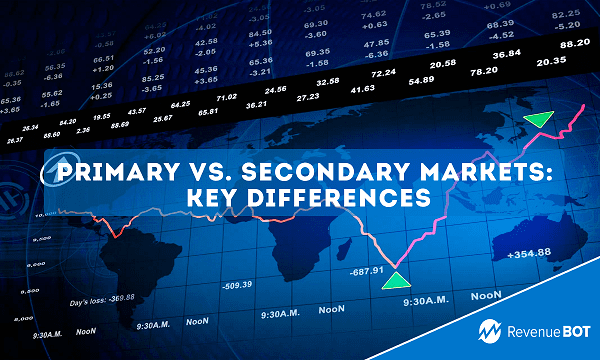
Cryptocurrencies and blockchain technology are now an integral part of the modern financial system, capturing the eyes of numerous investors and geeks of all kinds. Here we will dive into the realm of the crypto industry and take a look at two basic types of crypto markets – a primary market and a secondary (OTC, over-the-counter) one. These two concepts play a critical part in the lifetime cycle of any cryptocurrency and share a number of core differences, details of which we will explore.

Before you embark on your crypto journey, you will certainly bump into these two terms. So, ultimately, it should be much clearer which type is right for you.
Types of crypto markets
Crypto markets are platforms where various transactions in cryptocurrencies and linked assets take place. When it comes to dividing the crypto space, there exist several types of markets, each with its own characteristics, cycles, and functions. Let’s take a look at some of the most common types.
Primary market
The primary market is basically the place where new cryptocurrencies and tokens originate and are first introduced to investors. During this stage, projects hold Initial Coin Offerings (ICO) or Initial Exchange Offerings (IEO), offering tokens for sale. Investors can purchase tokens, often via any other cryptocurrency or traditional finance. It is an essential stage for startups and projects, as it allows them to raise the funds they need for their development.

Secondary market
At the secondary market, existing cryptocurrencies are traded and exchanged between investors. Here crypto prices form based on supply and demand, with trading taking place on crypto exchanges. Investors are free to buy and sell cryptocurrencies either for profit or to diversify their investment portfolios. The secondary market provides liquidity and enables investors to engage in dynamic asset allocation (DAA).
How does the primary market work?
The primary market is of paramount importance when it comes to the launch and distribution of new cryptocurrencies and tokens. Below you will learn in greater detail how such type of market works and which stages are included in the process of its functioning.
- Initiating the project. Within the primary market, greenfield projects and startups are launched by teams of developers and entrepreneurs. They elaborate a concept and a business plan for their cryptocurrency or token, outline the goals and strengths of the project, and decide on the volume and terms of token issuance.
- Preparing for sale. Once the project is established, the dev team proceeds with arrangements to sell the tokens on the primary market. They conduct a detailed study of the market, define a marketing strategy and take investors. Likewise, legal and technical aspects are being developed, including the project’s whitepaper, price and sales volume.

- Launching an ICO or IEO. When a crypto comes up for sale, Initial Coin Offering or Initial Exchange Offering is launched on the primary market. As part of an ICO or IEO, investors can purchase tokens by investing other cryptocurrencies (such as Bitcoin or Ethereum) or fiat into the project.
- Active stage of ICO/IEO. This may include running the developed platform, providing services or products, developing the ecosystem, and promoting the project in a marketplace.
What about the secondary market?
This type of market represents a fast-paced, vigorous marketplace where crypto and tokens are traded and exchanged.
- Cryptocurrency exchanges. The secondary market operates through specialized platforms known as crypto exchanges. Through these floors, investors have the opportunity to buy, sell, or exchange/swap crypto at current market prices. Crypto exchanges provide both crypto-to-crypto trading pairs and crypto-fiat combinations.
- Supply and demand. Here again, crypto prices take shape based on the interaction of supply and demand. If the demand for a particular cryptocurrency exceeds supply, the price surges, goes up. But if it’s vice versa, the price plunges, goes down. Thus, the secondary market is highly dynamic and subject to price volatility.
- Trading tools. Here in OTC market, investors benefit from a wide spectrum of trading tools, such as limit and market orders, as well as stop-losses and take-profit ones. With limit orders, you set the desired buy or sell price, while market orders allow you to perform a transaction at the current market price. Both Stop-Loss and Take-Profit orders serve to automatically close a position when certain levels of price are reached.
Conclusion
As far as the crypto industry is concerned, the primary and secondary markets are of essence regarding the development and functioning of cryptocurrencies and tokens. They empower investors to participate in projects, exchange assets, and earn potential profits.
What’s more, the primary market is where emerging projects obtain funding and backing from investors. Here product developers showcase their ideas, products, and technologies, whilst investors enjoy the opportunity to invest in forward-looking projects.
However, the secondary market offers investors the chance to trade and exchange already existing tokens and cryptocurrencies. This is where prices are formed based on supply and demand, and investors can employ a range of strategies to generate returns. Moreover, OTC market ensures liquidity and active trading, while also being associated with a high level of volatility and risk.
To sum up, the primary and secondary markets are intertwined and always complement each other. They pave the way for investors, entrepreneurs, and developers, fostering innovation and the proliferation of crypto. Yet to successfully participate in the market, you must do your own research, assess risks, and make informed decisions.
